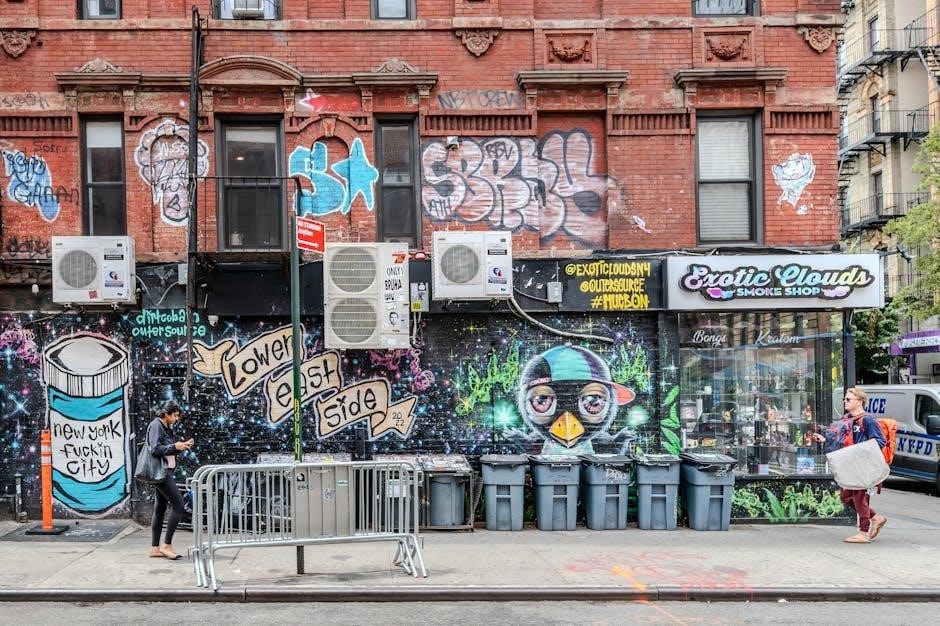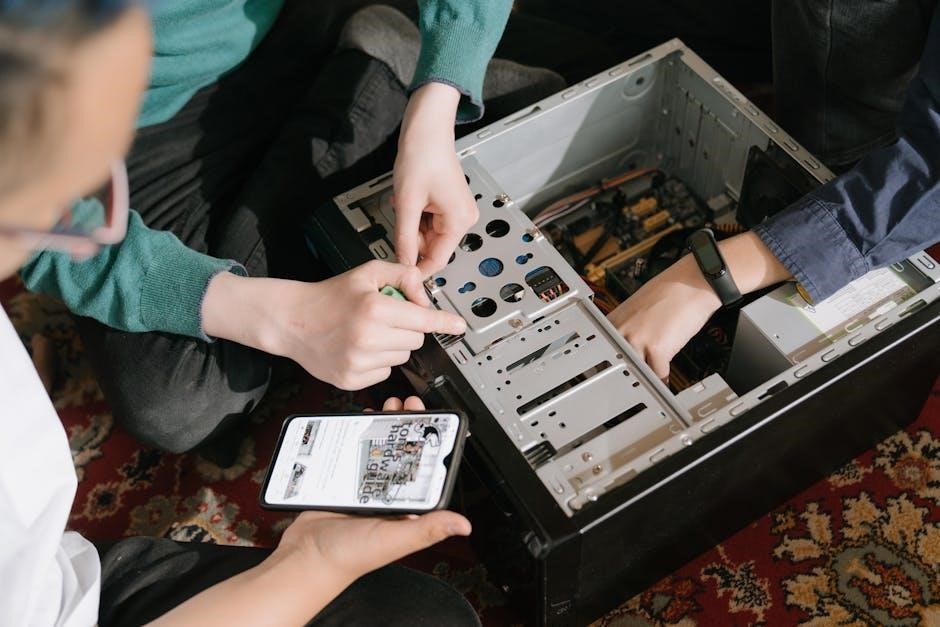
mitsubishi air conditioner troubleshooting guide
Mitsubishi air conditioners are reliable, but issues like blinking lights, water leaks, or system malfunctions can arise. This guide helps identify and resolve common problems efficiently, ensuring optimal performance and comfort. Proper troubleshooting can prevent costly repairs and extend the unit’s lifespan, while understanding error codes and maintenance tips ensures smooth operation year-round.

Common Issues with Mitsubishi Air Conditioners
Mitsubishi air conditioners often face issues like blinking lights, water leaks, or units not turning on. These problems may stem from maintenance oversights or technical faults, requiring prompt attention to ensure efficient operation and prevent further damage.
2.1. Mitsubishi AC Unit Blinking Lights
Blinking lights on a Mitsubishi AC unit indicate specific issues. For instance, 2 blinks may signal a thermistor malfunction, while 4 blinks could point to a compressor problem. Understanding these patterns is crucial for effective troubleshooting. Refer to the operation manual for detailed error code interpretations. If the issue persists after basic checks, such as ensuring proper power supply and clean filters, it may be necessary to consult a professional technician to address internal system faults and restore optimal functionality.
2.2. Mitsubishi Mini Split Leaking Water
A leaking Mitsubishi mini split can be caused by clogged drain lines, improper installation, or condensate pump failure. Regularly inspect and clean the drain line to ensure proper water flow. If the evaporator coil freezes, it can cause water to leak once it thaws. Check for blockages in the air filters, as restricted airflow can lead to ice buildup. Addressing these issues promptly prevents further damage and ensures efficient system operation. If the problem persists, consult a professional to rule out internal component malfunctions.
2.3. Indoor Unit Not Turning On
If the indoor unit of your Mitsubishi air conditioner isn’t turning on, check the power supply first. Ensure the circuit breaker hasn’t tripped and all switches are on. Verify the remote control has fresh batteries and is functioning correctly. Press the “ON” button firmly and ensure the thermostat is set properly. If the issue persists, inspect for loose wiring or faulty connections. Check for error codes on the remote or unit display, as they can indicate specific malfunctions. If troubleshooting doesn’t resolve the issue, consult a professional to diagnose internal electrical or component failures.

Understanding Mitsubishi Air Conditioner Error Codes
Mitsubishi air conditioner error codes provide crucial insights into system malfunctions. Codes like 1302 (high-pressure fault) or 1500 (refrigerant overcharge) help identify specific issues quickly, enabling targeted solutions to restore functionality and prevent further damage. Regularly reviewing error codes ensures optimal performance and extends the unit’s lifespan. Always consult the user manual or a certified technician for accurate troubleshooting and repairs.
3.1. High-Pressure Fault (1302)
Error code 1302 indicates a high-pressure fault in the Mitsubishi air conditioner. This occurs when the system’s pressure exceeds safe levels, often due to a refrigerant overcharge, blocked airflow, or faulty sensors. Immediate action is required to prevent compressor damage. Turn off the unit, check refrigerant levels, and ensure all vents are clear. If issues persist, a professional should inspect the system for internal malfunctions, ensuring safe and efficient operation. Always refer to the user manual for detailed troubleshooting steps and safety guidelines.
3.2. Refrigerant Overcharge (1500)
Error code 1500 signifies a refrigerant overcharge in Mitsubishi air conditioners. This occurs when excess refrigerant is present, disrupting system balance. Symptoms include reduced cooling performance and potential system shutdowns. Causes may include improper installation, a malfunctioning expansion valve, or refrigerant leaks. To resolve, turn off the unit and inspect for leaks. Check the thermostatic expansion valve for blockages or damage. If issues persist, consult a certified technician to safely adjust refrigerant levels and restore optimal operation. Always follow safety guidelines to avoid further system damage.
3.3; Drain Sensor Submersion (2500, 2502)
Error codes 2500 and 2502 indicate drain sensor submersion issues in Mitsubishi air conditioners. This occurs when the drain sensor detects excess water, often due to blockages or improper installation. Symptoms include system shutdowns and reduced performance. Check the drain line for obstructions and ensure proper installation. Clean or replace the sensor if corroded. Verify that the drain pan is correctly positioned and not clogged. Addressing these issues promptly prevents water damage and restores proper unit operation. Always refer to the manual for specific guidance and safety precautions.

Troubleshooting Steps for Mitsubishi AC
Start by checking the remote control signal and ensuring proper thermostat configuration; Inspect air filters for blockages and verify the power supply. Consult the manual for detailed guidance and address issues promptly to restore functionality.
4.1. Checking the Remote Control Signal
To troubleshoot the remote control signal, ensure the remote is pointing directly at the AC unit. Replace batteries if low, and check for obstructions. Verify signal transmission by testing buttons and observing the unit’s response. If issues persist, consult the manual or reset the remote. Ensure no interference from other devices. Proper signal transmission is crucial for operation. Addressing remote issues quickly prevents further system malfunctions and ensures smooth control over cooling functions. Regular checks can prevent signal-related problems. Always refer to the user manual for specific remote control troubleshooting steps.

4.2. Ensuring Proper Thermostat Configuration
Correct thermostat settings are vital for optimal AC performance. Ensure the thermostat is in COOL or HEAT mode and the desired temperature is set accurately. Check that the fan is configured to AUTO or ON for consistent airflow. Verify that the thermostat is clean and free from damage. If using a smart thermostat, ensure it is calibrated and synchronized with the AC unit. Proper configuration prevents issues like uneven cooling or system malfunctions. Always refer to the thermostat manual for specific setup instructions. Ensuring the thermostat is correctly configured is essential for efficient and reliable operation.
4.3. Inspecting Air Filters for Blockages
Air filters play a crucial role in maintaining airflow and efficiency. Regularly inspect filters for dust, debris, or mold buildup, which can restrict airflow and reduce cooling performance. Turn off the power, remove the filters, and clean them with a soft brush or replace them if damaged. Clean filters every 1-3 months to ensure optimal operation. Blocked filters can cause the unit to overheat or malfunction, leading to higher energy bills and reduced comfort. Proper maintenance ensures consistent airflow and keeps your Mitsubishi AC running efficiently throughout the year.

Advanced Troubleshooting for Mitsubishi Systems
Advanced troubleshooting involves diagnosing complex issues like refrigerant leaks, compressor malfunctions, and electrical faults. These problems often require specialized tools and professional expertise to resolve effectively, ensuring system longevity and optimal performance. Regular maintenance and timely repairs can prevent major breakdowns, while understanding error codes and system diagnostics helps in addressing root causes, enhancing overall efficiency and reliability of Mitsubishi air conditioners. This section guides users through detailed diagnostic steps and solutions for advanced issues, aiding in swift and accurate problem resolution to maintain consistent cooling and heating performance. Proper handling of such issues ensures safety and prolongs the system’s lifespan, avoiding costly repairs and downtime. By addressing these advanced problems, users can maintain their Mitsubishi systems in top condition, ensuring uninterrupted comfort and energy efficiency throughout the year. Regular inspections and proactive maintenance are key to preventing these complex issues from arising, while knowing when to involve professionals is crucial for resolving them effectively. This comprehensive approach ensures Mitsubishi air conditioners operate seamlessly, providing reliable service for years to come.

5.1. Refrigerant Leak Detection
A refrigerant leak is a critical issue that can cause reduced cooling performance, higher energy bills, and system damage. Signs include hissing sounds, ice buildup on coils, or warm air from vents. Detecting leaks requires professional-grade tools, such as electronic leak detectors or dye injection kits. Addressing leaks promptly is essential to prevent further damage to the compressor or other components. If left unchecked, refrigerant leaks can lead to system failure, requiring costly repairs. Always consult a certified technician for accurate diagnosis and safe repair to ensure optimal system performance and energy efficiency.
5.2. Compressor and Condenser Issues
Compressor and condenser problems are complex and can cause random shutdowns or reduced performance. Symptoms include unusual noises, reduced airflow, or the AC failing to cool. These issues often stem from faulty wiring, extreme temperatures, or blockages. Addressing them requires professional expertise to avoid further damage. Regular inspection of condenser coils and ensuring proper airflow can help prevent these issues. If left unchecked, compressor or condenser failure can lead to costly repairs or system replacement. Always consult a certified technician for accurate diagnosis and safe resolution to restore optimal functionality and efficiency.
5.3. Faulty Wiring and Electrical Problems
Faulty wiring or electrical issues can lead to intermittent system failures or complete shutdowns. Common problems include tripped circuit breakers, blown fuses, or loose connections. Overloaded circuits, power surges, or corroded wires can also disrupt operation. Symptoms may include the AC not turning on or shutting off unexpectedly. Addressing these issues requires turning off the power and inspecting the wiring. If electrical problems persist, consulting a licensed technician is essential to ensure safety and proper repairs, preventing further damage or potential hazards.

Preventative Maintenance Tips
Regular maintenance ensures optimal performance, prevents breakdowns, and extends lifespan. Clean air filters, inspect condenser coils, and check drain lines to maintain efficiency and reliability.
6.1. Regular Cleaning of Air Filters
Dirty air filters are a common cause of Mitsubishi AC issues. Regular cleaning ensures proper airflow, improving cooling efficiency and reducing energy consumption. Turn off the unit, remove the filters, and gently vacuum or wash them with mild soap. Allow them to dry completely before reinstalling to prevent mold growth. Cleaning every 1-2 months is recommended, especially in high-use environments. This simple step prevents system strain and enhances overall performance, keeping your space comfortable and your AC running smoothly.
6.2. Inspecting Condenser Coils
Condenser coils play a vital role in heat dissipation for Mitsubishi air conditioners. Regular inspection ensures they remain clean and undamaged. Check for dirt buildup, bent fins, or rust, as these can reduce efficiency. Clean the coils gently with a soft brush or garden hose, and straighten bent fins to maintain proper airflow. If damage is extensive, replace the coils to prevent system overheating and performance issues. Regular maintenance of condenser coils helps maintain cooling efficiency and extends the lifespan of your Mitsubishi AC unit.
6.3. Checking Drain Lines for Blockages
Regularly inspecting the drain lines of your Mitsubishi air conditioner is crucial to prevent water accumulation and potential leaks. Start by visually examining the drain line for visible blockages, such as dirt or mold buildup. Use a mixture of water and vinegar or a wet/dry vacuum to clean out debris. Ensure the drain pan is clear of water, as standing water can indicate a blockage; If the drain line is clogged, it may cause water to leak from the indoor unit. For severe blockages, consider professional assistance. Regular cleaning helps maintain proper drainage and prevents system malfunctions.

When to Call a Professional
While DIY troubleshooting can resolve many issues, certain problems require professional expertise. If you encounter error codes like high-pressure faults or refrigerant overcharge, or suspect refrigerant leaks, compressor failure, or electrical issues, it’s best to call a licensed technician. Additionally, if your system repeatedly shuts off, makes unusual noises, or fails to cool/heat after basic checks, professional assistance is recommended. Ignoring these signs can lead to costly repairs or system damage. Always prioritize safety and efficiency by consulting a certified expert for complex or persistent issues.